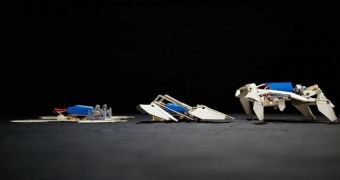Are you familiar with Shrinky Dink toys? The ones that shrink when you heat them in the oven? Well, a team of researchers from MIT and Harvard used them as a basis for what can only be called a self-folding robot.
Perhaps that is not altogether accurate though. After all, while the robot is built from the same polymer material as Shrinky Dinks, everything else has its roots in Origami.
Origami is an eastern art of folding paper that has a great track record when it comes to leaving us westerners and Central Europe citizens in the dust. The things that Origami can make from paper can be so complex but at the same time so graceful that even the best collages can seem pedestrian in comparison.
So, how does it work? The polymer sheet is the basis, but the embedded electronics and motors attached to the side are the ones that do the heavy lifting, so to speak.
The sheet folds when certain heating elements in its hinges are activated, while an embedded computer guides the hinges to follow a pre-determined order.
It takes about four minutes for the robot to fold into the intended shape, then the bot is ready to start walking around and doing its job.
And its jobs can be many, though the MIT team did specifically think, in particular, about search-and-rescue missions in collapsed buildings.
In theory, it should be possible to cut the sheet of polymer and install the motors on it in such a way that any origami shape could be created, but the research team has been trying to keep things practical for now.
Maybe in the future, however, self-folding sheets will be sold as origami guides, so that people may learn the beginnings of the art even if they can't find a teacher to help them.
In addition to Daniela Rus, director of the Computer Science and Artificial Intelligence Laboratory at the Massachusetts Institute of Technology in Cambridge, others worked on the self-folding robot.
They are, among others, Jacques Penders, an engineer who heads the Centre for Automation and Robotics Research at Sheffield Hallam University in the UK, Sam Felton, a mechanical engineer at Harvard, Harvard University in Cambridge, Massachusetts, and Robert Wood, who studies biologically inspired robots, also from Harvard.
At the moment, the next order of business is to make the robot a bit more stable, capable of holding better balance both while folding and after. Eventually, most robots should be able to self-build themselves this way, making them all cheaper and easier to distribute. If they ever get marketed, the robots will cost $100 / €100 to build in low quantities.

 14 DAY TRIAL //
14 DAY TRIAL // 